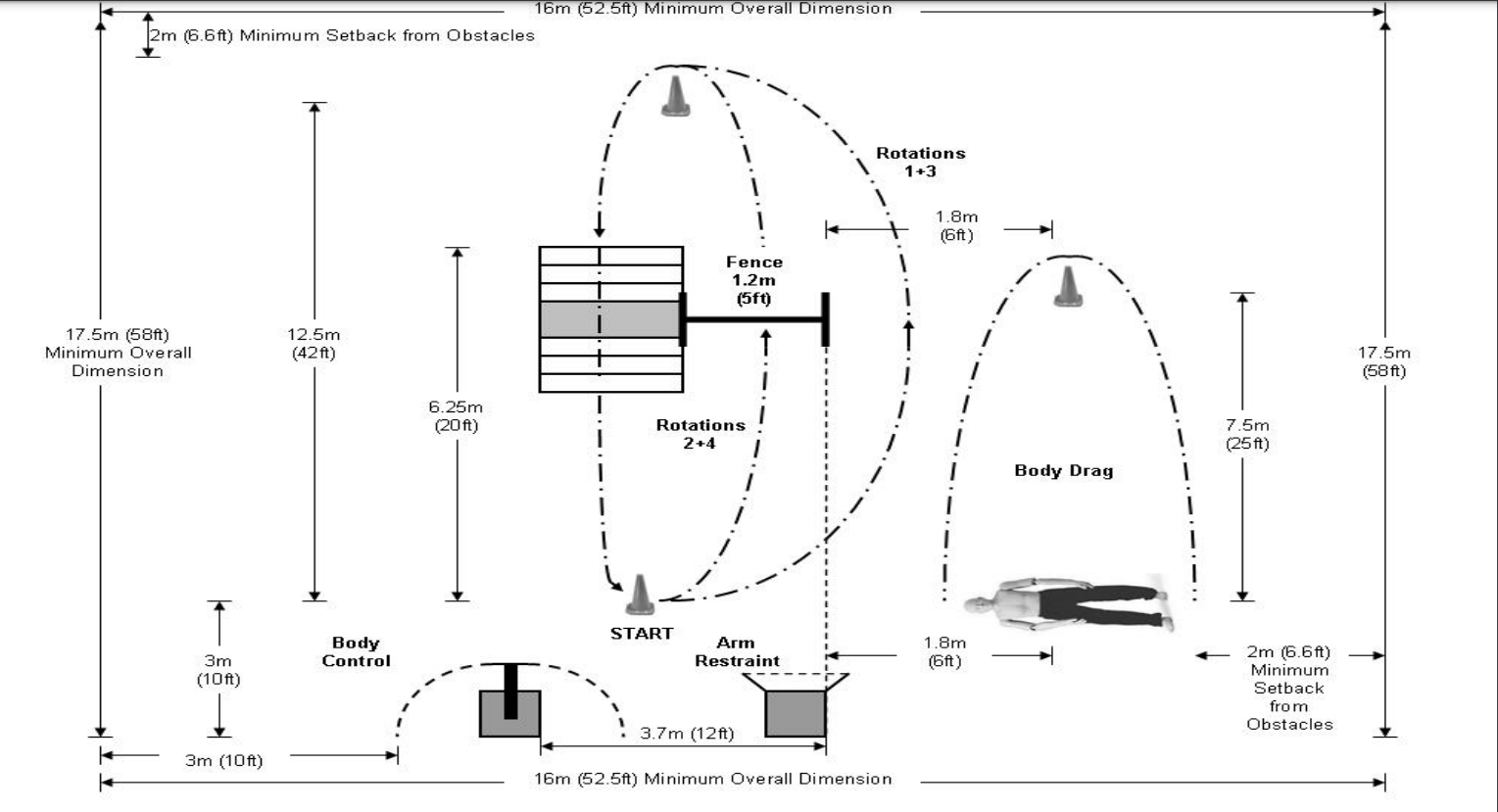City Police Fitness Prep
City Police Fitness Prep (A-PREP)
The Alberta Physical Readiness Evaluation for Police Officers (A-PREP) is the provincial standard used to determine the physical suitability of applicants for the Edmonton, Calgary, Camrose, Lethbridge, Medicine Hat, and Grande Prairie Police Services. Job simulation tasks put applicants in demanding conditions often faced by police officers. The A-PREP consists of a pursuit restraint circuit that simulates a foot chase and an aerobic shuttle run. Applicants will have to pass both components, on the same day, to pass.
Test results are valid for six months.
If the first attempt is not successful, an applicant may take it a second time on the next available testing session date with the agency you are applying to. Further failures after the second attempt will result in a two-month waiting period for each successive fail. Blue Line Fitness Testing does not conduct OFFICIAL testing for the A-PREP but we do run regular practice testing sessions and obstacle specific training.
Those who attend a Blue Line practice A-PREP session have proven a higher success rate than those who do not. We strongly encourage you to attend a session so you can learn the testing protocols, understand the requirements, and get technical advice on each task and obstacle. You’ll also have the chance to ask questions and practice the physical components of the City Police Fitness Prep test as many times as you’d like during the session.
🚨 Partnership Announcement! 🚨
Blue Line Fitness Testing has teamed up with the Edmonton Police Recruiting Unit to host female-only “Run with a Recruiter” sessions!
📍 When: 1st & 3rd Tuesday of every month
🕕 Time: 6:00 AM
💲 Cost: FREE
📌 Location: Blue Line Fitness Testing (5926 99 St NW, Edmonton)
These sessions are designed to help women prepare for the APREP — the physical fitness test required for EPS applicants. We’ll focus on building the strength, cardio, and confidence needed to pass and excel.
Whether you’re just getting started or gearing up for your test day, this is a supportive space to train, ask questions, and connect with recruiters.
No registration needed — just show up, ready to move!
How do I prepare?
Performing the A-PREP requires a combination of anaerobic fitness, cardiovascular endurance, and muscular strength & endurance. Anaerobic fitness is needed for activities that require maximal or near-maximal effort for a short period of time. High Intensity Interval Training exercises like our Titans classes are perfect to train for this!
Cardiovascular endurance is needed for activities that require oxygen to be delivered to the body for a considerable length of time. Run with a Recruiter (RWAR) are great opportunities to work on this! Muscular endurance allows an individual to maintain or repeatedly generate forces over a period of time. Muscular strength allows an individual to generate large forces over a short period of time and this is imperative for the dummy drag, push/pull machine and hand cuff simulator. Our A-PREP practice sessions are a great opportunity to practice on each of these obstacles.

City Police Fitness Prep has two main parts:
-
- a pursuit/restraint circuit that mimics tasks that may be performed on the job
- A multi-stage shuttle run that assesses cardiorespiratory fitness

Station 1: Obstacle course – foot chase
This simulates proceeding to the scene of a problem or occurrence.
The circuit simulates an emergency response in which a police constable pursues an offender a distance of 100 m while scaling four sets of stairs and two fences, engages in a physical altercation to accomplish the control and restraint of a resisting offender, then drags a passive resister or accident victim to a triage area. Throughout this test, you wear a weighted belt (7.5 kg or 16.5 lb) around your waist to simulate the weight of standard police equipment.
In the pursuit phase of the test, you run four laps around a 25-metre (83 ft) circuit as quick as possible for a total distance of 100 metres (332ft). During each 25-metre circuit, you climb a set of stairs and, during the second and forth rotations of the circuit, you scale a 1.5 –metre (5ft) fence. The fence is solid and has a toe-hold 18 inches above the ground. You must use the toe hold and roll over the fence.

Station 2: Push/pull section (physical control)
This simulates having to physically solve a problem or occurrence.
Immediately following the 100-metre (332 ft) circuit, you move to the Body Control Simulator (Push/Pull Machine) and grasp the handle. You then move through two 180º arcs switching back and fourth every 90º between pushing and pulling the handle to raise a weight of 34 kg (75 lb).
You then move to the Arm Restraint Simulator (Handcuff Machine) and grasp the handles, then depress the grips of both arms of the simulator. It takes 14.5 kg (32 lb) of force to depress each grip. With the grips constantly depressed, the arms of the machine are forced together and then returned to their starting position. It takes 16 kg (35 lb) of force to retract each arm.
You then return to the Body Control Simulator (Push./Pull Machine) and repeat the pushing and pulling to raise the 34 kg (75 lb) weight through two more 180º arcs (Figure 6).
You once again return to the Arm Restraint Simulator and repeat the arm retraction exercise.

Station 3. Torso Bag Carry (carry to safety)
This simulates having to remove an object or a person from the scene
Lastly, you grasp a 68 kg (150 lb) body and drag it a distance of 15 metres (50 ft). You may grasp the body by the wrists or by the ankles.
The Pursuit/Restraint Circuit is scored as the total time from the start of the 100-metre (332 ft) circuit to the completion of the body drag.
For successful completion of the Pursuit/Restraint Circuit the time must be 2 minutes and 10 seconds or less.
Following completion of the Pursuit/Restraint Circuit, you’re allowed a minimum 10-minute rest before beginning the aerobic fitness test.
STAGE 2
The Aerobic Fitness Test of the City Police Fitness Prep requires the completion of the 20-meter Shuttle Run (Leger or Beep Test), which is designed to evaluate aerobic fitness and work capability during physically demanding policing tasks as well as everyday policing activities.
In this test, you run back and forth between two marked lines over a 20-meter course in time with taped audio signals. The time permitted at the beginning of the test to cover the 20-meter distance requires a slow jog. Thereafter, for each 20-metres, the time between audio signals lessens, requiring that you pick up your running pace. The audio signal informs you of the “stage” you are at as the test progresses.
In each leg of the shuttle run, warning lines, placed 2 meters before each of the 20-meter end lines, must be reached before the permitted time elapses and the audio signal sounds.
An examiner will caution you if you fail to cross a warning line in time. The test ends when you miss two consecutive warning lines.
To successfully complete the minimum requirement of the aerobic fitness test you must achieve Stage 7.0 in the 20-metre Shuttle Run.
An acceptable score on the Aerobic Shuttle Run component requires approximately the same level of fitness as running 2.4 km (1.5 miles) in 11.5 minutes for a level 7.
Strategy for the Shuttle Run
While performing the shuttle run it is important to pace yourself at the beginning. The early stages of the test can be completed with a quick walk. It is best to pace yourself so that as you reach the opposite side, you can immediately turn around and return the other way. As the pace of the tones increases, increase the pace of your run. This will give your muscles a chance to warm up. It is a mistake to sprint in the early stages of the test and wait for the return signal. By practicing the Shuttle Run we encourage you to pace yourself to arrive at the 20m line at the sound of the audio signal.
Shuttle Run 20 Meter MP3 compliments of the OPP
An overall Meets Standard rating for the A-PREP requires that you complete the Pursuit/Restraint Circuit in 2 minutes and 10 seconds or less AND reach Stage 7.0 in the Leger 20-metre Shuttle Run.
